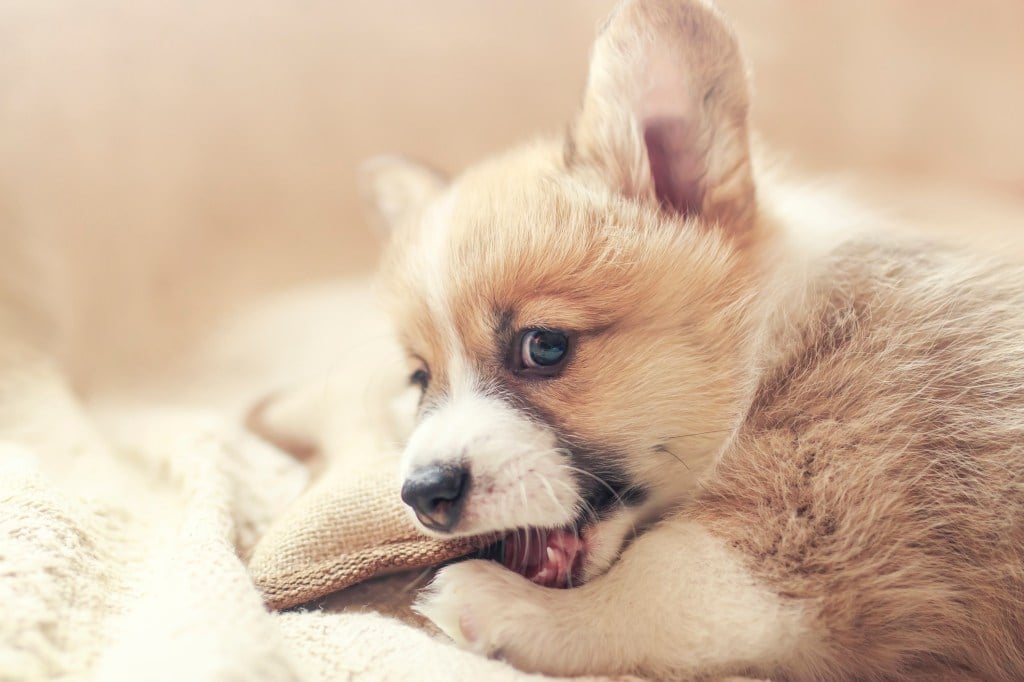Key Takeaways
- Essential dog supplies include a leash, collar, and ID tag.
- You’ll also need food, bowls, poop bags, and bedding.
- Dog insurance is important to your checklist to save money on vet bills.
- You may need to dog-proof various rooms of your house for safety.
- Make sure to supervise a new dog around your houseplants.
Table of Contents
You’re ready to add a dog to the family, which means you are about to embark on the exciting adventure of pet parenthood. Along with lots of love and attention, you’ll want to welcome your future companion home by providing a safe environment that is stocked with everything they’ll need. But where do you start? What supplies do you need? How do you puppy-proof your house? Let’s review.
Dog supplies
There’s a whole wide world of awesome pet supplies out there, but these are the staples that all dog households should have.
New dog supply checklist
- Leash and collar with identification tag
- Food formulated for your dog’s age (puppy, adult, or senior) or any dietary restrictions
- Bowls for food and water (ceramic or stainless steel are recommended since plastic scratches easily, leaving crevices for bacteria to build up)
- Bedding
- Poo bags
- Grooming supplies: pet shampoo, brush, toothbrush and toothpaste, nail clippers
- Crate and/or car restraint system (such as a seatbelt harness or barrier)
- Toys
- Treats
- Dog insurance: advances in vet technology can mean longer, healthier life for your pup, but new diagnostics and treatments can cost thousands of dollars. Dog insurance can pay up to 90% of vet bills from unexpected accidents and illnesses. Premiums can be surprisingly affordable, especially if you enroll your puppy early.
As you spend time with your dog, you’ll get to know the types of toys and treats they like most and what works best for them. For example, instead of a collar, you might opt for a harness; or if your dog turns out to be a fast eater, you may need to pick up a dog bowl designed to slow them down.
Dog and puppy-proofing
When it comes to bringing home a new dog, puppy-proofing doesn’t end when a dog hits a certain age. Whether your future pet is a young puppy or an adult dog, it’s wise to prepare your future dog’s surroundings by doing a safety check. Until you know the personality and tendencies of your adult dog, you should puppy-proof as though your new dog is just a few months old.
This may seem silly, but it’s helpful to get down on all fours to see your home through the eyes of a dog. From this new perspective, you’ll be able to see what they could access at their size, and if there are any potentially dangerous items beneath the furniture.
- Kitchen: Be sure all cleaning products are secure and the trash can is covered. If your dog figures out how to get into cabinets or open the lid on the trash, then it’s time to invest in child-proof latches. All food and treat bags (for both pets and people) should be kept well out of reach. A curious and hungry dog might eat something that will make him sick, or get his head stuck inside of a chip bag or plastic food container and quickly run out of oxygen.
- Living room: Children’s toys and remote controls can contain small parts and/or batteries that can be swallowed (batteries can cause burns and serious internal injury). Cords for blinds should be tied up and out of reach. Store purses and backpacks on hooks or in closets to prevent curious noses from rooting around. Make sure snacks and chewing gum is put up from reach, as they can contain xylitol which is extremely toxic to dogs.
- Bathroom: Place all toiletries well out of reach, including soaps, medication, cleaning supplies, and accessories. Wrap up dangling cords and use a trash can with a secure lid. Dogs may be drawn to the mysterious water bowl that is the toilet, which poses the threat of drowning, so be sure to keep the toilet lid closed. Your best bet is to simply keep the bathroom door closed at all times.
- Bedroom: Dogs are drawn to items that smell like their owners, and some are inclined to chew on those items. Put away stray clothing, shoes, or anything else you find on the floor. Be sure to also check under the bed for lost items such as coins or hair ties.
- Garage and outside: The garage is a great place to store all kinds of chemicals that are toxic to pets, such as rat poison, motor oil, and paint. Antifreeze in particular has a sweet taste that is attractive to animals, but is highly toxic, even in small amounts. Keep all of these items high and out of reach or locked up.
Some plants, like tulips, foxglove, and especially sago palm are poisonous to pets and can cause harmful effects if ingested. You can keep your new pal safe by supervising them at all times while outside until you can trust that they won’t munch on the plants. For dogs that just won’t leave plants alone, it’s best to remove any that are toxic to dogs.
Most of all enjoy this time with your new family member and make sure to spend a lot of time together to bond!








